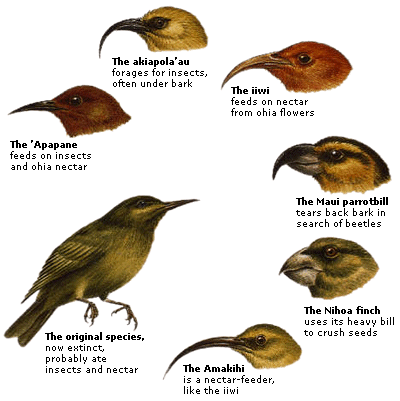EVOLUTION
- SPECIALIZED FOR SURVIVAL
- DUNKLEOSTEUS
- EVOLUTION OF THE ELEPHANT
- NATURAL SELECTION
- ADAPTATION
- FIND OUT MORE
The process by which changes occur in living things over
time is known as evolution. The changes are passed from one generation to the
next in genes. NATURAL SELECTION is one process by which evolution
may occur. In nature, individuals with an ADAPTATION that helps
them survive are more likely to reproduce. More of these individuals pass on
their genes than their rivals, so the adaptation is more common in the next
generation and builds up in the species.
Although the forelimbs of mammals, birds, and reptiles are modified
in different ways, the basic design is the same, suggesting they all descended
from a common ancestor. The basic design includes one upper arm bone, two lower
arm bones, and five fingers.
Some animals become extinct as a result of evolution. They are
replaced by other animals that are better able to survive.
Dunkleosteus was an armoured fish with powerful jaws
that lived about 350 million years ago. It may have become extinct as larger,
faster sharks evolved, out-competing it for the fish they both hunted.
EVOLUTION OF THE ELEPHANT
Today’s elephants are the result of a long process of
evolution. Over millions of years, small changes were passed from one
generation to the next. The first fossil elephant species were small, but over
time they increased both in size and weight. The three species alive today are
the sole survivors of a once much more widespread group.
Not all offspring survive to become adults. Those with
favourable variations, such as long, thick fur in a cold environment, are more
likely to survive than those without. This effect of different characteristics
on survival is what the scientist Charles Darwin called natural selection.
Natural selection is a cause of evolution but it is not the only
cause.
BIOGRAPHY: CHARLES DARWIN British, 1809-1882
Darwin spent years gathering evidence to support his idea of
evolution by natural selection. He travelled the world on expeditions aboard
the ship, HMS Beagle. When he reached the Galapagos Islands in the Pacific, he
was inspired by the number of unique species he found there.
During the Industrial Revolution in the 1880s, pollution blackened
trees in parts of England. Previously rare black peppered moths began to
increase, as they were harder for birds to spot than their speckled
counterparts. By 1900, most moths in industrial areas were black. Now, with
pollution controlled, the black population has fallen again.
Adaptation is an outcome of natural selection. It is the
gradual matching of an animal to its environment over time. It applies to
everything about an animal from its anatomy and behaviour to its life cycle. It
is important in evolutionary terms because the better adapted an animal is, the
more likely it is to survive and produce offspring.
The marine iguana lives on the Galapagos Islands and feeds
exclusively on seaweed. It shows a number of adaptations to this lifestyle.
Because it feeds underwater, the marine iguana is a good swimmer and has a long
tail, flattened from side to side, to help propel it through the water. It also
has special glandular structures in its nose to help it get rid of excess
salt.


No comments:
Post a Comment